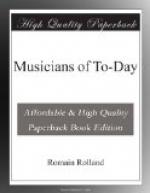The achievement of an artistic ideal so restricted as this would not have sufficed, however, to assure the success of the Schola Cantorum, nor establish its authority with a public that was, whatever people may say, only lukewarm in its religion, and that would only interest itself in the religious art of other days as it would in a passing fashion. But the spirit of curiosity and the meaning of modern life began to weigh little by little with the Schola’s principles. After singing Palestrinian and Gregorian chants at the Church of Saint-Gervais during Holy Week, they played Carissimi, Schuetz, and the Italian and German masters of the seventeenth century. Then came Bach’s cantatas; and their performance, given by M. Bordes in the Salle d’Harcourt, attracted large audiences and started the cult of this master in Paris. Then they sang Rameau and Gluck; and, finally, all ancient music, sacred or secular, was approved. And so this little school, which had been consecrated to the cult of ancient religious music, and had made so modest a beginning,[229] developed into a School of Art capable of satisfying modern wants; and in 1900, when M. Vincent d’Indy became president of the Schola, it was decided to move the school into larger premises in the Rue Saint-Jacques.
The programme of this new school was explained by M. Vincent d’Indy in his Inauguration speech on 2 November, 1900, and showed how he based the foundations of musical teaching upon history.
“Art, in its journey across the ages, is a microcosm which has, like the world itself, successive stages of youth, maturity, and old age; but it never dies—it renews itself perpetually. It is not like a perfect circle; it is like a spiral, and in its growth is always mounting higher. I believe in making students follow the same path that art itself has followed, so that they shall undergo during their term of study the same transformations that music itself has undergone during the centuries. In this way they will come out much better armed for the difficulties of modern art, since they will have lived, so to speak, the life of art, and followed the natural and inevitable order of the forms that made up the different epochs of artistic development.”
[Footnote 229: When Charles Bordes opened the first Schola Cantorum in the Rue Stanislas he was without help or resources, and had exactly thirty-seven francs and fifty centimes in hand. I mention this detail to give an idea of the splendidly courageous and confident spirit that Charles Bordes possessed.]
M. d’Indy claims that this system may be applied as successfully to instrumentalists and singers as to future composers. “For it is as profitable for them to know,” he says, “how to sing a liturgic monody properly, or to be able to play a Corelli sonata in a suitable style, as it is for composers to study the structure of a motet or a suite.” M. d’Indy, moreover, obliged all students, without distinction, to attend the lectures on vocal music; and, besides that, he instituted a special class to teach the conducting of orchestras—which was something quite new to France. His object, as he clearly said, was to give a new form to modern music by means of a knowledge of the music of the past.




